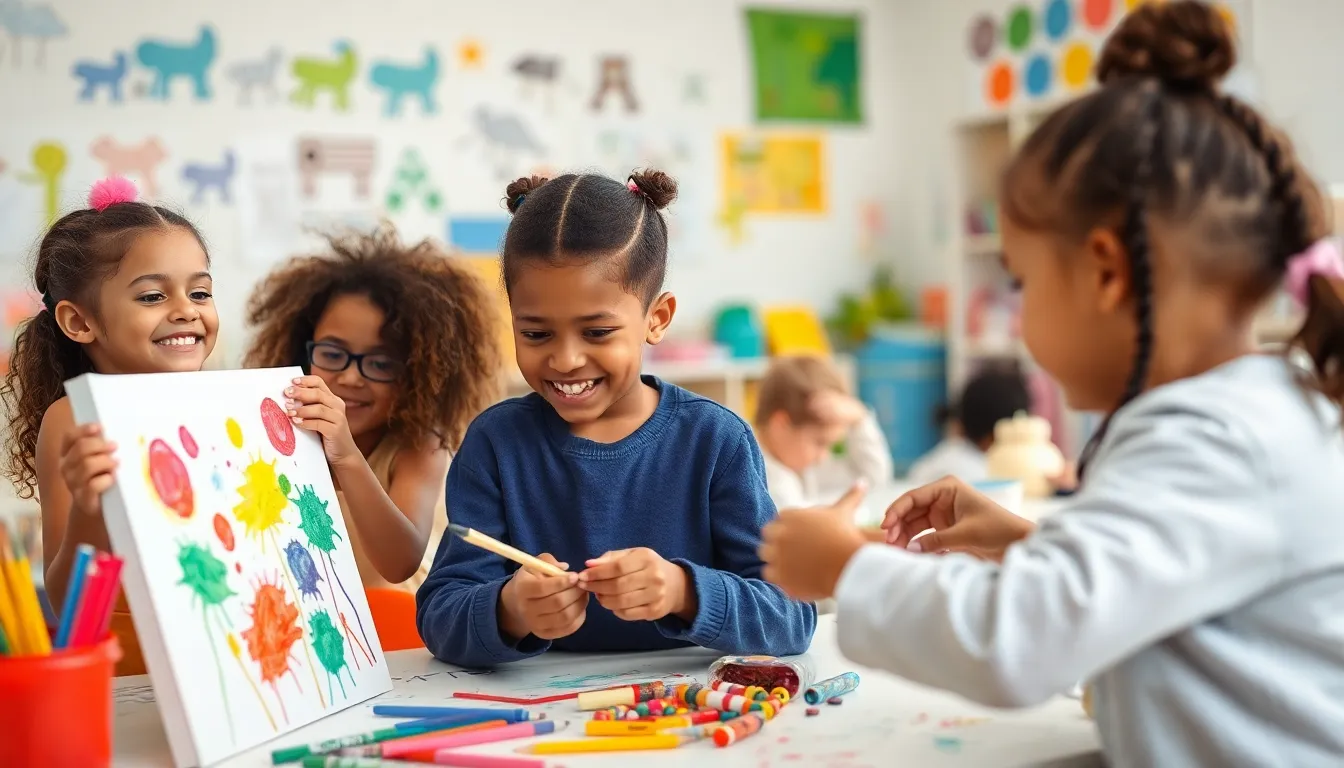Kids art projects aren’t just about splashes of paint and glitter explosions; they’re gateways to creativity and boundless imagination. Every masterpiece starts with a simple idea, and the right project can turn a rainy day into a vibrant adventure. From finger painting to DIY crafts, these activities not only keep little hands busy but also spark joy and learning.
Imagine a world where macaroni becomes a majestic sculpture and paper plates morph into colorful animals. With the right guidance, kids can unleash their inner Picassos, all while developing essential skills like fine motor coordination and problem-solving. So grab those crayons and let the fun begin! It’s time to dive into a colorful realm where every creation is a reason to celebrate.
Table of Contents
TogglePopular Kids Art Projects
Kids art projects encompass a variety of activities that engage creativity while refining skills. Here are some popular ideas.
Drawing and Painting Ideas
Drawing and painting serve as fundamental activities for children. Finger painting encourages expressive and tactile creativity, while watercolor techniques introduce color blending. Crayon resist art combines crayons with watercolors, creating surprising effects. Nature-themed drawings inspire exploration, allowing kids to capture their surroundings artistically. Collaborating on large canvas projects fosters teamwork, helping children communicate ideas and share perspectives. Encouraging self-portrait drawings promotes self-esteem and reflection. Ultimately, these activities invite imagination and nurture artistic talents.
Craft Projects Using Recyclables
Craft projects using recyclables provide valuable opportunities for creativity and environmental awareness. Empty boxes transform into imaginative playhouses or robots, inspiring inventive designs. Plastic bottle planters allow kids to create unique garden decorations while learning about plants. Paper towel rolls can become fun puppets or creative decorations. Magazine collages encourage kids to express their thoughts through visual storytelling. Creating art from everyday materials cultivates resourcefulness and reinforces the importance of recycling. These projects unite creativity and sustainability seamlessly.
Benefits of Kids Art Projects

Kids art projects offer numerous advantages that contribute to a child’s growth and development. Engaging in these activities allows children to explore their imaginations while building essential skills.
Boosting Creativity
Creativity flourishes through diverse art projects. Engaging in drawing, painting, and crafting allows children to express themselves without barriers. They develop original ideas and innovative solutions as they work on various themes and materials. Exploring different art forms, like abstract painting or sculpture, further enhances their imaginative capabilities. Children learn to think outside the box as they combine colors, shapes, and techniques. Each creation becomes a unique reflection of their thoughts, boosting their confidence in artistic expression.
Enhancing Motor Skills
Motor skills improve significantly through hands-on art projects. Manipulating tools such as crayons, brushes, and scissors hones hand-eye coordination. Children refine their grip and dexterity, which translates to better control in various tasks. Activities like cutting out shapes or painting intricate details promote fine motor development. Crafting projects that require assembling materials encourage problem-solving skills as children navigate construction challenges. Progress in these areas supports their overall physical development and prepares them for future academic activities.
Tips for Successful Kids Art Projects
Successful kids’ art projects require thoughtful planning and an inviting atmosphere. Strategically choosing materials and creating a fun environment enhance engagement and creativity.
Choosing the Right Materials
Selecting appropriate materials for art projects remains crucial. Non-toxic paints, colorful markers, and sturdy papers attract children’s attention. Incorporating natural elements like leaves or twigs encourages exploration of textures. Ready-to-use supplies simplify preparation for parents. While traditional tools like brushes and crayons work well, innovative items like sponges or finger paint also excite young artists. Emphasizing the importance of variety ensures every child finds an outlet that resonates with them. High-quality, versatile materials stimulate creativity and provide enduring enjoyment.
Creating a Fun Environment
Crafting an enjoyable workspace promotes excitement and innovation. Brightly colored tables or art stations invite creativity. Chaos can reign, so designating a specific area for art projects keeps mess contained. Encouraging free expression helps children feel comfortable to experiment with their ideas. Playing music in the background often enhances the creative flow. Displaying completed artworks fosters a sense of accomplishment and pride. Prioritizing collaboration among children leads to shared experiences, making each project more memorable. Celebrating the process over perfection ignites a positive atmosphere natural for artistic exploration.
Age-Appropriate Projects
Engaging in art projects varies by age, allowing children to explore their creativity at different developmental stages.
Projects for Toddlers
Toddlers enjoy simple, hands-on projects that foster exploration. Finger painting stands out as an excellent option, offering sensory experiences while encouraging imagination. Collages using cut-up magazines and natural materials like leaves or flowers also promote tactile interaction. Simple shapes made from playdough stimulate fine motor skills. Activities focused on colors, such as sorting or matching, delight toddlers while enhancing cognitive development. Parents can introduce themed projects, such as animal art using paint or crayons, to capture their child’s interest.
Projects for School-Aged Children
School-aged children can tackle more complex projects that challenge their creativity and skills. Drawing and painting activities allow for individual expression and introduce various techniques, such as brushwork or shading. Crafting projects using recycled materials, like creating bird feeders from plastic bottles, promote innovation and environmental awareness. Collaborative art sessions with peers can enhance social skills and teamwork, particularly through group murals or sculptures. Encouraging the use of diverse tools, such as stencils and stamps, enriches their artistic experience. The versatility of projects provides opportunities for self-discovery and idea development.
Kids’ art projects offer a world of possibilities for creativity and growth. These activities not only entertain but also play a crucial role in developing essential skills. By engaging in art, children learn to express themselves and explore their unique ideas.
Parents can enhance their children’s artistic journey by providing the right materials and a supportive environment. Celebrating each creation fosters confidence and encourages a love for creativity. As kids dive into various projects, they build a foundation for future learning and self-discovery.
Ultimately, art projects are more than just fun; they’re vital for a child’s development, nurturing both imagination and practical skills that last a lifetime.




